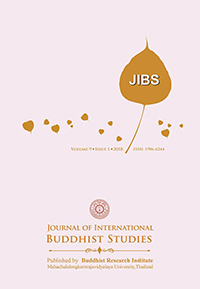Understanding Noble women in Jataka stories
Keywords:
Understanding, Noble women, in Jataka storiesAbstract
Women in the Buddhist world generally take on more subservient roles than their male counterparts. By and large their culture has trained them to accept their subordinate positions, and the foundations of that culture are directly intertwined with Buddhism. This trend of the subordination of women is present in Buddhist cultures from the ancient past until the present. However, the researcher personally feels that the roles women have been forced to accept are perhaps not inherent in Buddhism, but rather stem from different interpretations of the Buddhist scriptures. This study is based on the research and examination of documents. It is also a combination of several methods for studying literature. The reader-oriented approach and hermeneutics of interpretation are two of the most effective tools I have employed. For the Burmese, there are four foremost noblest women appeared in Jataka stories. These four noble women are Amāra (Jātaka No.546); Kanari (Jātaka No.485), Maddī (Jātaka No. 547) and Sambula (Jātaka No. 519). These four noble women illustrate the qualities of true love, compassion and great wisdom, providing an archetype of the ideal mother and wife for Burmese women. Burmese women are inspired to imitate them during the course of their lives, wholeheartedly taking on the different roles a woman has to perform. However, it seems that differing interpretations of the same story can lead to a variety of possibly conflicting conclusions. This paper is to depict these four noblest women’s contribution towards their partner in his path to perfection. It will also remind those who might have forgotten the virtues of these ladies and how these stories might still be relevant in the 21st Century.
References
A. Primary Sources
Cowell, E. B. (ed. – several translators) (1995). (1895-1907). The Jātaka or Stories of The Buddha’s Former Births. Vol. I & II, Vol. II, Vol. III & IV, Vol. IV, Vol. V & VI, Vol. VI. Oxford: The Pali Text Society.
Horner, I. B. Ten Jātaka Stories. A Pali Reader. Mahamakut Rajavidyalaya Press. Bangkok. 1974.
U Ah Ba Tha, Min Pu Sayadaw. Pondawson Zat Kyi Se Bwe. Ten Jātaka Stories with Illustrations. Vol. I & II. (in Burmese language) Yangon: Khin Cho Tun Sapay. 2000.
B. Books and Articles
Amporn Srisermbhok, PhD. Literary Criticism: Approaches to Feminist Literature. Bangkok. Santisiri Press. 2003.
Appleton, Naomi. Biography and Buddhahood: Jātaka Stories in Theravada Buddhism. A Thesis submitted for the degree of Doctor of Philosophy in Oriental Studies & Wolfson College, University of Oxford. 2008.
Boonsue, Kornvipa . Buddhism and Gender Bias: An Analysis of a Jātaka Tale. Religion and Culture Research Center. The Hague: Institute of Social Studies.1986.
Collins, Steven. Nirvana And Other Buddhist Felicities: Utopias of the Pāli Imaginaire. UK: Cambridge.1998.
Gross. Rita, M. Buddhism after Patriarchy: A Feminist History,Analysis, and Reconstruction of Buddhism. India: Sri Satguru Publications. 1993.
Sanisuda Ekachai. “Madsi: A Female Bodhisattva” in Keeping the Faith: Thai Buddhism at the Crossroad, pp. 197 -202.2001.
Suwanna Satha-Anand. “Moral dilemma in the Bodhisattva Ideal:
A Reading of Vessantara Jātaka Tale.” In Manusya: Journal of Humanities. Vol. 7. No. 2 September 2004. Thailand: Chulalongkorn University.2004.
Suwanna Satha-Anand. “Madsi: a Female Bodhisattva Denied?” In Virada Somswasdi and Sally Theobald eds., Women, Gender Relations and Development in Thai Society, Vol.1. Chiang Mai: Women’s Studies Center, Faculty of Social Sciences, Chiang Mai University. pp 243-256. 1997.







